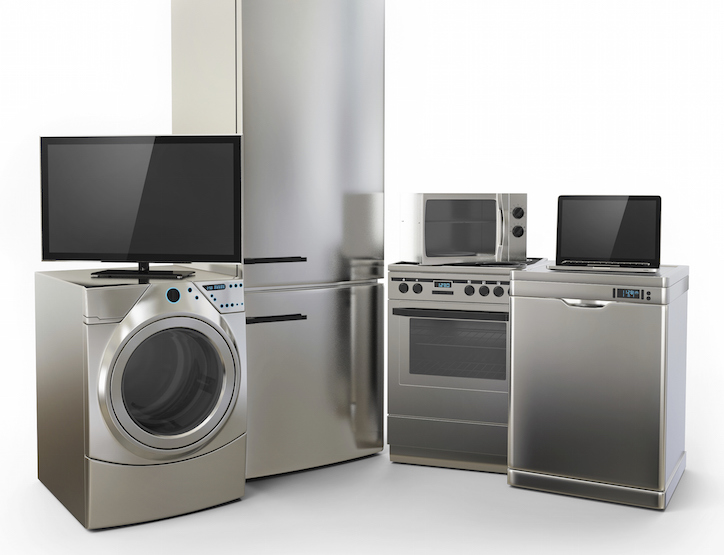
New Prototyping Technologies for Appliance Manufacturing
During the prototyping stage in appliance manufacturing, quick turnarounds for low-cost, small-batch production runs are key to iterating a new product successfully. As a result of these demands, many appliance design engineers have eschewed metal prototyping since common methods such as die casting or die stamping are cost-efficient only at large volumes.
However, multiple new developments in prototyping technologies have made metal a viable and even preferable material for prototyping for appliance manufacturing.
Plastic has also become a practical alternative material for making prototypes. In fact, many lighting prototypes used to be made exclusively from glass and metal, but due to new developments in transparency and heat resistance, functional lighting prototypes can now be made from plastic polymers instead.
Below, we outline the new developments in both metal and polymer prototypes and examine each method’s advantages and drawbacks for appliance manufacturing.
New Metal Prototyping Technologies
To keep prototyping costs low, plastic is often used to create models of metal parts. However, plastic can cause difficulties in replicating the true function and manufacturability of metal parts. Six new prototyping technologies allow appliance manufacturers to create faster, cheaper metal prototypes, even in small batches.
Investment, Sand and Plaster Casting
Three different types of casting may be used to create metal prototypes: investment casting, sand casting, and plaster casting.
Investment casting usually starts by creating a 3-D wax model, covering it in ceramic, and baking it. After the ceramic bakes, the wax is melted, removed, and replaced with liquid metal. Once the metal hardens, the ceramic mold is broken and the part is removed. The process is then begun again for the next part.
Sand casting creates a multipart mold from sand or clay. Metal is then poured into the mold and left until it solidifies. The mold is then broken and removed from the part and the process is repeated for the next prototype.
Plaster casting is similar to sand casting. It produces a smoother finish than sand casting but can only be used for non-ferrous metals such as aluminum.
Selective Laser Sintering & Metal Coating
Aside from casting, prototypes can be made using selective laser sintering (SLS), which builds parts by melting successive layers of powder with a laser. The powder is often a metal/plastic composite, so the resulting prototype usually has the aesthetic properties of a die-cast part, but not the functional ones.
Similarly, a different process called metal coating takes a base non-metal form, usually made of plastic, and coats it with a metal surface.
Machining
Machining, which produces parts directly from metal stock, was once only used for large production runs because it was too cost-prohibitive and time-intensive for prototyping.
Today, though, thanks to the ability to convert 3-D CAD designs to toolpaths for machining equipment, both the time and cost have been greatly reduced, making machining a suitable option for prototyping for appliance manufacturing — particularly when it is necessary to match the functionality of a final die-cast or die-stamped part.
Polymer Prototyping for Appliance Lighting
Previously, plastics could not replicate the transparency of glass or the heat resistance of metal, rendering them useless for creating lighting prototypes for appliance manufacturing.
However, new developments in plastics have made them equal to (and sometimes better than) metal and glass when it comes to producing lighting prototypes. In addition, LED lights now emit less heat than traditional lights, further reducing the need for glass and metal prototypes.
Transparency
Advances in prototyping technologies have increased the transparencies of various thermoplastics until they are on par with that of many glass materials, around 90-percent light transmittance.
Polycarbonate (PC), acrylic (PMMA), styron clear polystyrene resin, and clear K-Resin can all match the average light transmission of glass, making these injection-molded plastics excellent options for lighting prototypes for appliance manufacturing.
Conductivity
Plastic resins cannot match the conductivity of true metals, but they can provide thermal conductivity that is up to 500 times greater than regular plastics. In addition, they also offer several advantages over metal, including lighter weights and corrosion resistance.
Heat Resistance
Unlike thermoplastics (which soften when heated), thermoset plastics harden when heated, making them an excellent choice for lighting prototypes for appliance manufacturing.
In particular, flexible liquid silicon rubber (LSR) has several qualities that make it an ideal material for lighting, including great flexibility, scratch- and crack-resistance, and up to 94 percent light transmission.
Shapes
Lighting shapes that cannot be molded can instead be made using stereolithography (SL), an additive manufacturing process that builds parts using successive layers of photopolymer resin.
SL parts are nearly free from distortion but their flexibility does come at a cost: The process does not result in truly optical parts and UV exposure can cause the optical additive materials to deteriorate.
Choosing a Prototyping Technology for Appliance Manufacturing
Selecting the right prototyping technology for appliance manufacturing can be difficult, especially given the numerous techniques that have recently been developed.
3-Dimensional Services offers many of these prototyping processes, so if you would like to see if one of these new prototyping technologies meets your prototyping or low-volume production needs, please contact us for more information.
